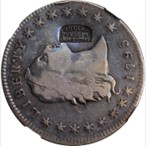
PREV ARTICLE
NEXT ARTICLE
FULL ISSUE
PREV FULL ISSUE
V25 2022 INDEX E-SYLUM ARCHIVE JACOB HOUCK'S COUNTERSTAMPHouck's Panacea counterstamps are popular in collecting circles, appearing on a number of U.S. and foreign coins. An article by Jeff Oertel in the March 2022 issue of John Reich Journal, the official publication of the John Reich Collectors Society discusses the life and business of its creator, Jacob Houck of Baltimore. With permission, we're publishing an excerpt. Thanks to JRJ editor Brad Karoleff for passing along the text and images. -Editor
The Houck's Panacea stamp is certainly one of the most popular counterstamps yet far from the rarest. There are likely well over one hundred known stamped coins with most of these being half dollars. There may be fewer than ten stamps on early dollars, of which there are at least two stamps found on flowing hair dollars. Half dollars dating from 1829 to 1836 comprise most of the stamped coins, therefore capped bust type half dollars. There are a few draped bust halves with the stamp. There are at least six early quarters known to have the stamp. In addition to the United States coins, the stamp is found on France 5 Francs, Mexico/Spanish 1 and 2 Reales, Brazilian 960 Reis and a Prussian Taler. If a counterstamped coin issued after 1836 is found, such as a Seated Liberty coin, it would be a rare use of the stamp. To be sure, Houck did not waste his stamp on such low denomination coins as large cents. Virtually all coins but the early dollars and foreign coins have the stamp in the same location, vertically situated in front of Liberty's face. Brunk indicates that there are two varieties of the stamp, the common one as shown within this article and another with a serrated top. Only one is known to exist. The Houck's Panacea stamps, used for advertising, were most likely made just after Houck gained approval for his patent, which was in 1833. It is uncertain why Houck stopped stamping coins after 1836. Houck did continue to advertise in newspapers and flyers and did so through at least 1842. He also issued his own paper notes to advertise his product and location. So, who was the person behind the special formula, the advertising and the stamp? This is where the erroneous information begins, and this seems to go back well over one hundred years. Note that the full names of the key people involved are used throughout to help avoid confusion and make clear the actual story.
Jacob Houck (no middle name used or found) was born in 1792 near Frederick City, Maryland. In 1811 he married Elizabeth Trisler and they raised a family of three boys. Jacob Houck was a merchant and had a I was unaware of the scrip notes. What a great pairing for an exhibit! -Editor
For more information on the John Reich Collectors Society, see:
Wayne Homren, Editor The Numismatic Bibliomania Society is a non-profit organization promoting numismatic literature. See our web site at coinbooks.org. To submit items for publication in The E-Sylum, write to the Editor at this address: whomren@gmail.com To subscribe go to: https://my.binhost.com/lists/listinfo/esylum All Rights Reserved. NBS Home Page Contact the NBS webmaster 
|



